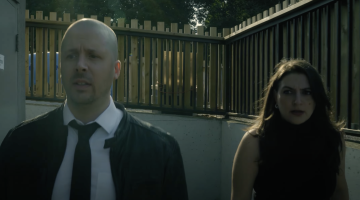Like their corporate brethren, many people who work in the public sector relish the chance to escape from the relentless grind of a 9-to-5 day job. While some feel that such workers are little more than inefficient bureaucrats, those critics never consider that public employees have meaningful and fascinating lives while off the clock.
Now streaming on its official web site, plus YouTube (see additional links below), Stareable and Ottawa arts blog apt613.ca, filmmaker Amen Jafri’s new 3 episode documentary series The Secret Lives of Public Servants entertainingly states that thesis. Filmed in and around Canada’s national capital, Ottawa, the series focuses on three Canadian government employees who spend their downtime in highly creative ways.
The first episode features Marc Adornato, who puts his skills as an artist to spectacular use by creating provocative sculptures from existing materials. Frequently seen bicycling at night while clad in a suit and gas mask, Adornato has won both acclaim and controversy through much of his politically-themed works.
Such a character could easily be found in a comic book, and chances are that Canada’s National Food Inspection Agency speechwriter/senior communications adviser Janet Hetherington might be illustrating it. A prolific artist, Hetherington created and published the Eternal Romance series in 1997, before working on other popular franchises like Elvira: Mistress of The Dark.

Costumed cosplayer Richard Wong, one of three talented people featured in the new documentary series THE SECRET LIVES OF PUBLIC SERVANTS.
Like the mild-mannered characters of Clark Kent, Bruce Wayne and Peter Parker, National Gallery of Canada security officer Richard Wong instantly transforms himself into their larger than-life alter egos.
Only he does so through designing and wearing elaborate character costumes (a.k.a. cosplay). Wong makes regular appearances at various Comic-Cons and charitable events, including for the Ottawa-based children’s organization League of Superheroes.
Similar to the people she’s interviewed in The Secret Lives of Public Servants, Jafri has also spent years as a public employee in Canada’s government.
At the same time, she’s explored her own creative talents through documentary filmmaking. In 2014, Jafri’s acclaimed feature debut The City That Fun Forgot? explored how and why Ottawa became notorious among Canadians for supposedly being a boring place to live.
With The Secret Lives of Public Servants, Jafri now trains her lens on a heretofore unexplored aspect of government employees: the previously hidden talents they possess, and the incredible ways that they share those talents in everyday life. The series was nominated for Best Documentary Series and Best Cinematography at this year’s Brooklyn Web Fest, and an expanded second season is now in the works.
While more stories are certain to be told in future episodes of the series, the story of how The Secret Lives of Public Servants came to be merits its own exploration.
Having recently left the public sector, Jafri explains that the idea behind The Secret Lives of Public Servants was formed during an otherwise quiet pause in her previous job’s workday. Her memories of that experience, and the extensive efforts she took to produce the series, are examined in this profile for Snobby Robot.
SR: How, and when, did you come up with the idea for The Secret Lives of Public Servants?
Amen Jafri: It’s a funny story. It started inside a cubicle, back when I was a federal public servant in Ottawa, Canada (I left in 2016 to work in broadcasting and focus more on filmmaking). It seemed that every other day a new daily notice would arrive that someone was retiring in our department. During a lull, a macabre idea for a short story occurred to me. What if public servants weren’t retiring, but being taken out, one by one, under the guise of retirement?
That idea didn’t last long, of course, but the title I had conjured up for it did: The Secret Lives of Public Servants. I loved this title and I began to investigate what truly entailed the seedy underbelly of the public service. While it’s certainly out there, my husband suggested a more lighthearted approach and to take a look at the creative hobbies of bureaucrats instead.
SR: What inspired you to create the series?
AJ: As a public servant, I happened to know a lot of colleagues who had these secondary lives outside their day jobs and if it wasn’t me that directly knew them, then it was through family and friends. As well, I was someone pursuing a “secret life” as a filmmaker too. It seemed like a fun type of story to tell, one that hadn’t been told and different from the stock story of public servants as boring, lazy and corrupt.

Behind the mask is provocative artist Marc Adornato, the first subject of filmmaker Amen Jafri’s new series THE SECRET LIVES OF PUBLIC SERVANTS.
I also enjoy narratives that explore what is typically hidden on a day-to-day basis and often these types of stories aren’t regularly shared in office settings or they are minimized in importance because they are “hobbies” and not directly related to the day job. I often found that most people I knew in offices who would only ever talk about the same things while making small talk: their kids’ accomplishments, food and exercise, or their errands.
Not that there is anything wrong with any of this, of course, but in my experience that is also what is seen as acceptable to discuss in office settings. And hearing about some of these secret lives seemed so refreshing because it was different, unexpected and generally kept guarded around the proverbial water cooler.
SR: How does The Secret Lives of Public Servants stand out from other documentaries (including your own past work), plus series that revolve around the subject of public workers?
AJ: Other than the wonderful comedic fictional series out there like Parks and Recreation and (the U.K. sitcom) The Thick of It, I can’t think of any other documentary film that has truly explored this topic or put the spotlight on public servants as people. I am extremely proud of this web series and my goal in setting out to make it was to elevate it above my past work by collaborating with a talented crew.
I know my own talents and limitations, and I think it’s important to find other people who can enhance and bring to the table their own specialized skills to create a strong product. I think anyone who is interested in better understanding the strangers in our lives, as well as quirky and interesting characters, will be drawn to this documentary series.
I am continually drawn to documentaries (Sarah Polley’s award-winning 2012 feature Stories We Tell, Albert Maysles’ 2014 film Iris, etc.) that explore the lives of quirky, unconventional people!
SR: How did you identify with the people featured in the show?
AJ: Many people I interviewed, especially the cast, are involved with their secret life because they have to do it. It’s almost not a choice, because you can’t imagine leading your life in any other way and it gives your life meaning. I also related to their attraction to joining the public service because they wanted to make a difference in peoples’ lives and because it offers a good income with benefits and it’s secure. It feels like a win-win for all involved.

Amen Jafri, creator of the new documentary web series THE SECRET LIVES OF PUBLIC SERVANTS.
SR: Describe how you went about finding the people you interviewed in this series.
AJ: I originally wanted to have eight public servants featured in eight different episodes. I started with former colleagues, who I thought had extensive secondary lives outside of work, that the public would consider unusual for a public servant to have.
I also thought about if they and their hobby would translate well on camera for viewer engagement: were they articulate and interesting to listen to and was their hobby something that could be captured visually?
I also put out a few call-outs on social media and through family/friends that I was seeking potential cast members. I wanted to have diverse representation in terms of hobbies, departments and backgrounds, so I also did my own research, typing in key words on Google to see if any news story had appeared, mentioning public servants with interesting hobbies. I ended up finding Marc through the P.R. rep I had first hired for the crowdfunding campaign, Janet through my husband (also a public servant) and Richard through a media interview.
SR: Talk about the research/interview process for each episode, and what challenges you faced during production.
AJ: For each cast member, I interviewed them to determine if they would be a good fit for the series I had in mind and I also asked them if their day job would be okay with us filming them at work. I asked them some questions I would later ask on camera, such as how they balance their day job with their work life, how secret this life is for them, as well as if there were any upcoming events that they would be engaging in, to show them in their element.
I visited their workplaces (with the director of photography, whenever possible) and homes to figure out what we could shoot and what would look good visually on screen. During the shoot, I would interview them at the day job and in their home. There were enormous challenges shooting just three episodes alone. A major one was coordinating everyone’s schedules, cast and crew, since we all have other jobs. I also initially thought it would be a good idea to shoot in the summer, when it would be quieter in the cast’s day jobs, but of course that is also the time when everyone likes to go on vacation!
Finally, I had (to) wait on approval from each of the day jobs, to know that we had security clearance to go in to the workplaces and that would often take a long time to receive. There would also be specific requirements, such as avoiding shooting in certain areas and ensuring we had a security representative with us on site. I also had to deal with the chance that we would not be approved.

Acclaimed comic book artist Janet Hetherington, part of a fascinating look at the hidden talents of Canadian federal employees in THE SECRET LIVES OF PUBLIC SERVANTS.
SR: Discuss the production of each episode.
AJ: The production process involved the shoot in the workplace, in the home and at an event, that would show the cast member in their element. The scheduling aspect of it was the most challenging, particularly in terms of trying to be cost-effective.
I would try to schedule at least two shoots on the same day, even if they were for different cast, but that wasn’t always possible because either we were waiting on permission from the workplace or anticipating when the next upcoming event would be that related to the cast member’s secret life.
For “The Cosplayer”, I needed to drive to Toronto. While our sound person was available, I had to find a different local DOP/camera operator. Since this was the first time I was working with a crew and playing the dual role of producer and director, I had to keep track of time, (plus) the shot list, (and) any spontaneous moments that would arise. (I would) continually try to communicate what I was trying to express to the crew, or adjust my expectations depending on what was technically feasible.
SR: You’re already planning a second season of the series, and have talked about expanding its geographic scope. How so, and will the scale of production increase with it?
AJ: I would like to continue to do profiles on public servants in Ottawa, but I’d also like to feature public servants in other parts of Canada and at least one in another country. Other than the travel costs, the scale of production would not increase otherwise.
SR: How will viewers benefit from watching this series, and from learning about the people featured in it?
AJ: I think they will be surprised at just how funny, interesting and intelligent these public servants can be, because I think they truly do defy your stereotypical image of a bureaucrat. Viewers may also be emotionally struck by what drives our cast to pursue their secret lives and how it broadly speaks to what we are all striving to find: some sense of meaning and purpose in our lives.
SR: Do you feel that viewers will come away with a greater appreciation for public employees, the work that they do, and the talents they possess?
AJ: Absolutely. An appreciation for the fact that there are a lot of public servants who are truly passionate about making a difference in their countries, that there is a lot more depth and humanity there than you initially assume, that there are a lot more artists/creatives in the public sector than you might imagine and that these are people you can connect and relate with.

The masked man, revealed: artist Marc Adornato, first featured in THE SECRET LIVES OF PUBLIC SERVANTS.
SR: What are your overall hopes for the show’s success?
I want this series to become part of the conversations that happen not just in the public service, but also any 9-5 workplace. I want us to question and reflect on this division between who we present ourselves as during our day jobs and in our private lives.
There’s a richness to these hobbies and/or secret lives that is neglected when workplaces create a culture that diminishes their importance in favor of the work that must be completed by day. I would love to connect with employees and managers who want to bring this series into the workplace for workshops and conferences and develop a discussion guide for them to continue the conversation.
SR: What’s the main theme of The Secret Lives of PublIc Servants?
AJ: The primary theme for the series is to not underestimate the depth and complexity of people stuck in the daily grind. When you’re in an office and someone tells you what they did on the weekend or after work, they’re only revealing one very small aspect of themselves and that’s one that they feel safe and comfortable to disclose.
(NOTE: Jafri says that the series will be closed-captioned, beginning with its first episode.)
ON THE WEB (Jafri’s web site): http://amenjafri.com/
YOUTUBE (Jafri’s channel): https://www.youtube.com/channel/UCGfhQuhmKmxmG7N21L6jf4A
FACEBOOK: https://www.facebook.com/SecretLivesPS/
TWITTER: https://twitter.com/SecretLivesPS










No Comment